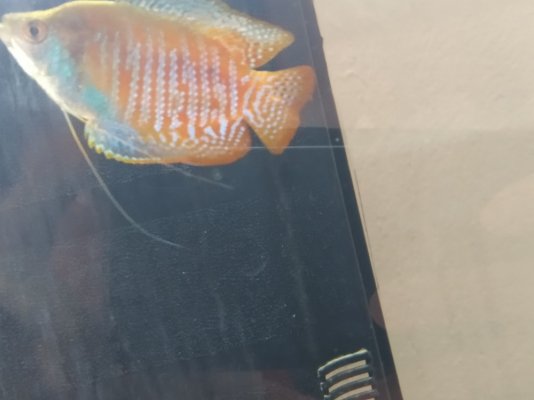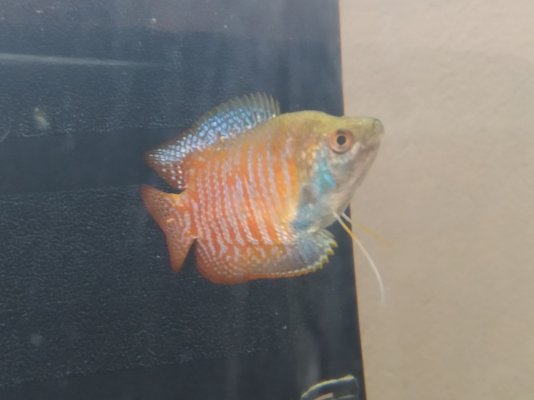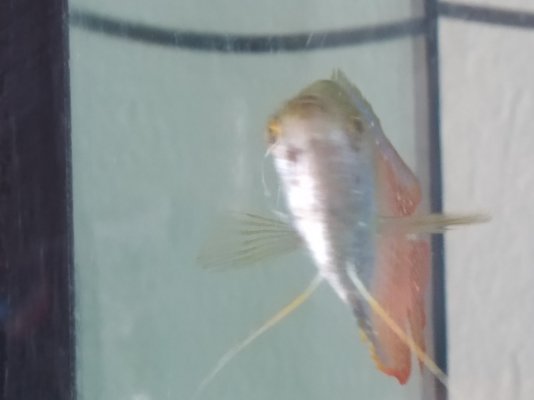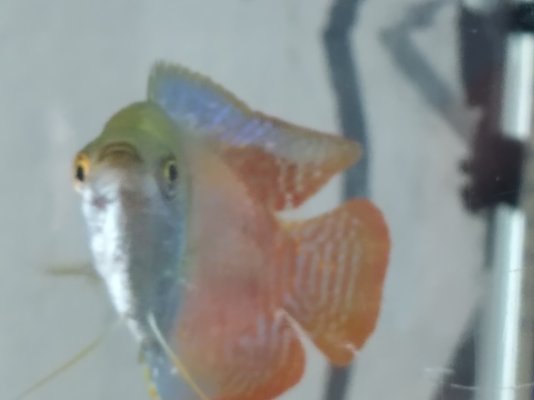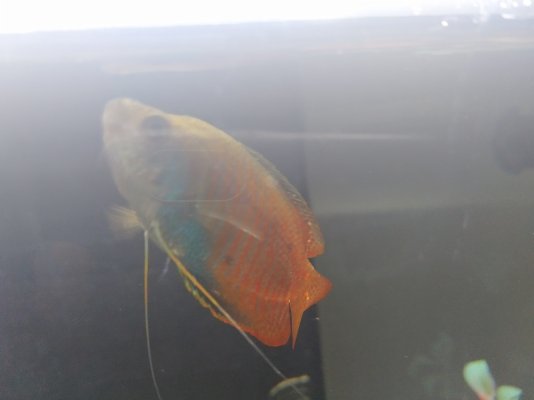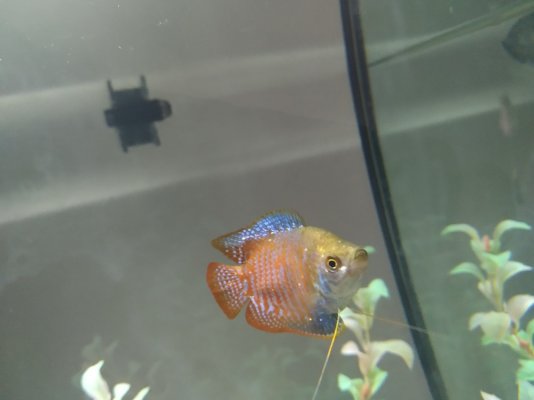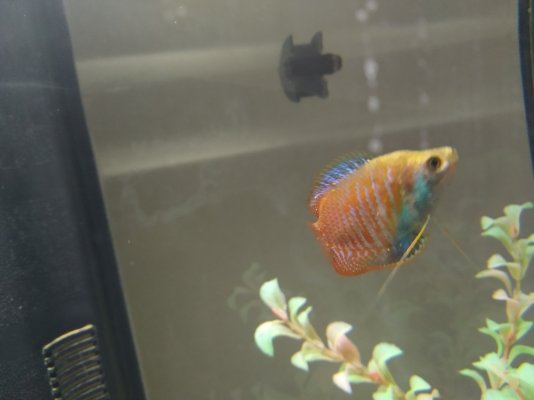I have noticed some white spots on my gourami but I can't tell if it's early stage ich or not. Any opinions would be appreciated.
You are using an out of date browser. It may not display this or other websites correctly.
You should upgrade or use an alternative browser.
You should upgrade or use an alternative browser.
Does my dwarf gourami have ich
- Thread starter Ategnatos
- Start date
The friendliest place on the web for anyone with an interest in aquariums or fish keeping!
If you have answers, please help by responding to the unanswered posts.
If you have answers, please help by responding to the unanswered posts.
Colin_T
Aquarium Advice Addict
Its too hard to tell from the pictures due to them being blurry. If you can take some more pictures and check them on your computer, then post a couple that clearly show the issue, it would help.
Have you added anything to the tank in the last 2 weeks?
How long have you had the gourami for?
How long has it had the spots?
What other fishes are in the tank?
-------------------
You can treat white spot by raising the water temperature to 30C (86F) and keeping it there for 2 weeks, or at least 1 week after all the white dots have gone. The heat will kill the parasites during its free swimming stage and you won't need chemical medications.
You can use heat for 2 weeks just in case it is white spot. Most tropical fishes are fine with 30C for a couple of weeks.
If the water temperature is 25C or above, just turn the heater up to 30C and let it go up.
If the water temperature is below 25C, then raise it up to 30C over a 24 hour period.
Monitor the water temperature with a thermometer in the water.
-----------
If the heater has trouble holding the temperature at 30C, you can insulate the base, back and sides of the aquarium with 1-2 inch thick sheets of polystyrene foam. Just tape them to the outside of the tank.
A coverglass on the tank will also help trap heat. Use 4, 5, or 6mm thick glass, rather than the 2 or 3mm thick glass sold in most pet shops. The thicker glass holds heat better and is less likely to chip or crack compared to thinner glass.
-----------
Before you raise the water temperature, do the following:
Wipe the inside of the glass down with a clean fish sponge. This removes the biofilm on the glass and the biofilm will contain lots of harmful bacteria, fungus, protozoans and various other microscopic life forms.
Do a 80-90% water change and gravel clean the substrate. The water change and gravel cleaning will reduce the number of pathogens in the water and gravel so there are fewer to infect the fish.
Make sure any new water is free of chlorine/ chloramine before it is added to the tank.
Clean the filter if it hasn't been done in the last 2 weeks. However, if the filter is less than 6 weeks old, do not clean it. Wash the filter materials/ media in a bucket of tank water and re-use the media. Tip the bucket of dirty water on the garden/ lawn. Cleaning the filter means less gunk and cleaner water with fewer pathogens to infect the fish.
Increase surface turbulence/ aeration to maximise the dissolved oxygen in the water.
Have you added anything to the tank in the last 2 weeks?
How long have you had the gourami for?
How long has it had the spots?
What other fishes are in the tank?
-------------------
You can treat white spot by raising the water temperature to 30C (86F) and keeping it there for 2 weeks, or at least 1 week after all the white dots have gone. The heat will kill the parasites during its free swimming stage and you won't need chemical medications.
You can use heat for 2 weeks just in case it is white spot. Most tropical fishes are fine with 30C for a couple of weeks.
If the water temperature is 25C or above, just turn the heater up to 30C and let it go up.
If the water temperature is below 25C, then raise it up to 30C over a 24 hour period.
Monitor the water temperature with a thermometer in the water.
-----------
If the heater has trouble holding the temperature at 30C, you can insulate the base, back and sides of the aquarium with 1-2 inch thick sheets of polystyrene foam. Just tape them to the outside of the tank.
A coverglass on the tank will also help trap heat. Use 4, 5, or 6mm thick glass, rather than the 2 or 3mm thick glass sold in most pet shops. The thicker glass holds heat better and is less likely to chip or crack compared to thinner glass.
-----------
Before you raise the water temperature, do the following:
Wipe the inside of the glass down with a clean fish sponge. This removes the biofilm on the glass and the biofilm will contain lots of harmful bacteria, fungus, protozoans and various other microscopic life forms.
Do a 80-90% water change and gravel clean the substrate. The water change and gravel cleaning will reduce the number of pathogens in the water and gravel so there are fewer to infect the fish.
Make sure any new water is free of chlorine/ chloramine before it is added to the tank.
Clean the filter if it hasn't been done in the last 2 weeks. However, if the filter is less than 6 weeks old, do not clean it. Wash the filter materials/ media in a bucket of tank water and re-use the media. Tip the bucket of dirty water on the garden/ lawn. Cleaning the filter means less gunk and cleaner water with fewer pathogens to infect the fish.
Increase surface turbulence/ aeration to maximise the dissolved oxygen in the water.
I have examined the DG further and I am pretty sure it's ich. I have been cycling my 20G tank with 2 DG for a month now and I started noticing these spots on one of them yesterday. I haven't added anything in the tank since I set it up.
Colin_T
Aquarium Advice Addict
If you haven't added anything to the tank in a month, it is unlikely to be white spot. The white spot parasite multiplies pretty quickly and one individual can turn into hundreds in 4 or 5 days at 25C.
However, if you do think it is white spot, then raise the water temperature to 30C (86F). The warmer water will help the beneficial filter bacteria grow faster and speed up the cycling process too.
However, if you do think it is white spot, then raise the water temperature to 30C (86F). The warmer water will help the beneficial filter bacteria grow faster and speed up the cycling process too.
Colin_T
Aquarium Advice Addict
Some of the spots look like white spot but there are other small spots near the tail where it meets the body, which appear to be red. Are these spots red or white?
If they are red spots, then I doubt it's white spot.
I would raise the water temperature to 30C and monitor it over the next week or two. It could be something much more interesting than white spot.
If they are red spots, then I doubt it's white spot.
I would raise the water temperature to 30C and monitor it over the next week or two. It could be something much more interesting than white spot.
Colin_T
Aquarium Advice Addict
Interesting as in the red dots could be something new to science, even if it's a new disease 
Similar threads
- Replies
- 1
- Views
- 95
- Replies
- 1
- Views
- 254
- Replies
- 5
- Views
- 366
- Replies
- 3
- Views
- 283
- Replies
- 1
- Views
- 346

